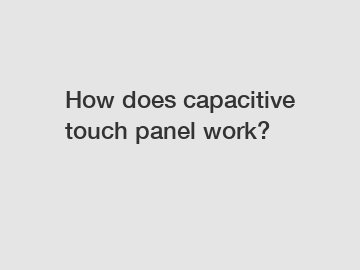How does capacitive touch panel work?
How Does a Capacitive Touch Panel Work?
In today's era of smart devices, touchscreens have become a ubiquitous feature. Whether on smartphones, tablets, or even modern kitchen appliances, capacitive touch panels have revolutionized user interactions by providing a seamless and responsive interface. But have you ever wondered exactly how capacitive touch panels work? In this article, we will delve into the technology behind capacitive touch panels and explore how they enable our touchscreen experiences.
What is a Capacitive Touch Panel?

A capacitive touch panel is a type of touchscreen technology that detects and tracks the electrical properties of a conductive object, typically the human finger. Unlike resistive touch screens, which rely on physical pressure, capacitive touch panels operate based on the principles of capacitance.
Understanding Capacitance.
Capacitance refers to the ability of an object to store an electrical charge. In a capacitive touch panel, a grid of conductive materials, such as indium tin oxide (ITO), is embedded beneath a durable protective layer, like glass or plastic. This grid forms an arrangement of small capacitors. When a finger or any conductive object comes into proximity with the surface, it interferes with the electric field, altering the capacitance.
The Principle of Mutual Capacitance.
Capacitive touch panels utilize the principle of mutual capacitance to accurately detect touch positions. The grid of capacitors consists of rows and columns. Each intersection acts as a sensing node. An integrated circuit, known as a touch controller, continuously measures the capacitance at each node, allowing it to determine the precise location of the touch event.
Secondary Heading: Multi-Touch and Gestures.
Multi-touch gestures have become an essential aspect of modern touchscreens. Whether it's pinch-to-zoom or swiping between screens, capacitive touch panels excel at recognizing and interpreting these gestures. This capability is achieved by tracking and analyzing the changes in capacitance as multiple fingers interact with the touchscreen simultaneously. Advanced algorithms within the touch controller can accurately detect and differentiate between various gestures, enhancing the overall user experience.
Secondary Heading: Benefits and Limitations.
Capacitive touch panels offer several advantages over other touchscreen technologies. They provide a more sensitive and accurate response, enabling smoother and faster interactions. The absence of physical pressure required for input makes them more durable and resistant to wear and tear. Additionally, capacitive touch panels offer better optical clarity due to the absence of additional layers required in resistive touchscreens.
However, capacitive touch panels do have their limitations. They can only detect conductive objects, which means traditional touch with gloves or non-conductive styluses may not work. Additionally, they are more susceptible to false touches caused by water or other conductive materials, requiring additional measures such as waterproof coatings for certain applications.
Understanding how capacitive touch panels work enhances our appreciation for the technology that has transformed the way we interact with devices. By harnessing the principles of capacitance, these touchscreens enable a more intuitive and seamless user experience.
In conclusion, capacitive touch panels have become an integral part of our everyday lives. Their ability to accurately detect touch events through mutual capacitance enables the smooth operation of modern touchscreens. Despite their limitations, capacitive touch panels continue to advance, delivering more precise and immersive user interactions.
If you have any further questions or would like to explore more about capacitive touch panel technology, please do not hesitate to contact us.
For more information, please visit Advantages and Disadvantages of Resistive Touch Screen, Monitor Ik10, Multi Touch Panel Producer.
82
0
0

Comments
All Comments (0)